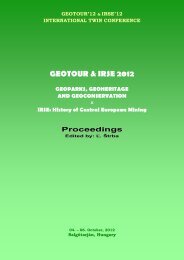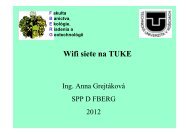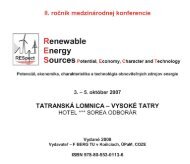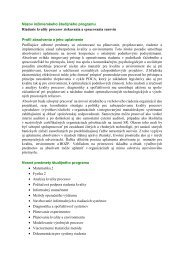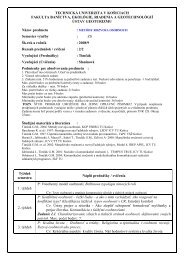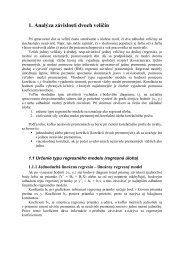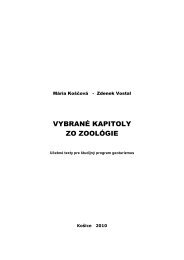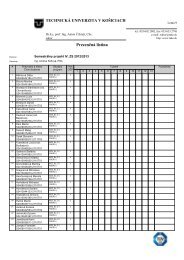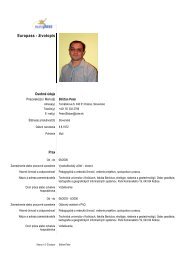GEOTOUR & IRSE 2012.pdf - Fakulta BERG - TUKE
GEOTOUR & IRSE 2012.pdf - Fakulta BERG - TUKE
GEOTOUR & IRSE 2012.pdf - Fakulta BERG - TUKE
You also want an ePaper? Increase the reach of your titles
YUMPU automatically turns print PDFs into web optimized ePapers that Google loves.
Salgótarján, 04. – 06. October 2012<br />
developments of minor significance can be financed rather from internal resources. The<br />
micro-regions have to designate those narrow areas of development that carry the chances for<br />
sustainable tourism growth (e.g. villages in extraordinary landscapes at the foot of the Bükk<br />
Mountains). An increase of the significance of tourism cannot be expected without the<br />
systematic cooperation of local governments and micro-regional centers.<br />
The tourism supply of Bélapátfalva, Pétervására, Abaúj-hegyköz, Füzesabony micro-regions<br />
far outweighs the economic opportunities. The Abaúj-hegyköz micro-region is in the period<br />
of fast growth, whereas the Bélapátfalva micro-region is in the period of slowing growth. The<br />
signs of decline can be experienced in the Pétervására and Füzesabony micro-regions. The<br />
sources of the further development of tourism can come almost exclusively from external,<br />
primarily domestic resources. The narrow sources of the local governments and the small<br />
number of highly skilled professionals form a barrier to winning tender sources. Further<br />
results can be expected from investment incentive, investment supporting programs that<br />
promote regional tourism potential.<br />
The Mezőkövesd, Rétság, Szécsény micro-regions have less significant “tourism supply” than<br />
the previous group but have somewhat more favorable economic potential. The Mezőkövesd<br />
micro-region is in the period of dynamic development, the Rétság micro-region in<br />
„revitalization‟, whereas the Széchenyi micro-region is in decline. The Mezőkövesd microregion<br />
is on growth track B due to its tourism supply; the regional significance of tourism is<br />
less significant in the other two cases. It is predominantly the Mezőkövesd micro-region that<br />
can expect grant funding; in the case of the other two, their location near Budapest and<br />
utilizing the Old Village of Hollókő and its Surround-ings to a greater extent may bring<br />
results. The Mezkövesd micro-region, capitalizing on its excellent availability, should expand<br />
its catchment area, both inside and outside the region.<br />
The Heves, Mezőcsát, Bodrogköz, Szikszó and Encs micro-regions belong to those lagging<br />
behind in the national rank on the basis of their economic power. Their tourism supply and<br />
performance is negligible, which is even coupled with decline. There is a small chance for the<br />
regional-level development of tourism. The Mezőcsát and Heves micro-regions are in the best<br />
position, as they can utilize their excellent accessibility, the proximity of Lake Tisza and a<br />
thermal water supply. The tourism developments can come almost exclusively outside the<br />
region. In my opinion, only isolated development can be expected. For the majority of the<br />
micro-region‟ settlements, it would be worth trying to find other means of encouraging<br />
development/growth.<br />
The “tourism supply” and economic performance of the Bátonyterenye, Pásztó, Szerencs,<br />
Edelény and Ózd micro-regions are deeply below average. The visitor turn-over is negligible<br />
compared to the population, and processes of marginalization have been typical for long<br />
years. Apart from some exceptions (e.g. Edelény), significant tour-ism investments cannot be<br />
expected from internal and external (private or budgetary) resources. Special attention has to<br />
be paid in the case of tourism development so that the criteria of sustainability are complied<br />
with. The Szerencs micro-region undeservedly belongs to this group, since its settlements<br />
belonging to the wine-region, the architectural and cultural heritage of Szerencs would justify<br />
tourism development. The development of the micro-region‟s accommodation supply is<br />
reasonable, especially in the core area of the Tokaj Wine Region (historic cultural landscape -<br />
World Heritage Site) [4].<br />
CONCLUSION<br />
The last two decades have brought significant mostly positive changes to the operation of the<br />
thermal baths in Hungary. Thanks to the Széchenyi Plan and the National Development Plan<br />
several baths were refurbished and modernized. However we can not be satisfied intense<br />
competition can be expected in the near future but effective service development and<br />
marketing communication can provide a competitive advantage. The region‟s economic<br />
52



